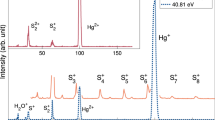Summary
The Raman spectrum of selenic acid has been investigated in the state of solid, liquid and aqueous solutions of concentrations varying from 92·5% to 7 ·5% by weight. The solid has yielded eight lines with frequency values of 1383, 930, 896, 778, 766, 374, 355 and 327. Marked changes in position, intensity and character of these lines are observed during the transition from the solid to the liquid and then to the aqueous solutions. The gradual disappearance of some of the lines and the increase in the intensity of some others and the appearance of new lines are explained on the basis of the stepwise dissociation of the acid, namely, H2SeO4 → HSeO4′ + H° and HSeO4′ → SeO4″ + H°. The results indicate that the first stage of ionisation starts from the solid and the second stage from about 50% concentration. The results are compared with those of its analogue, sulphuric acid and conclusions are drawn regarding the structure and the apparent shifts of the bands in both these acids. The changes that take place in the lines during the transition from the solid to the liquid are characteristic of the hetro-polar nature of the chemical bond in the acid molecules.
Similar content being viewed by others
o|
Venkateswaran, C. S.,Proc. Ind. Acad. Sci., A, 1935,2, 119; 1936,3, 25.
Ganesan, A. S.,Proc. Ind. Acad. Sci., A, 1934,1, 156.
Venkateswaran, C. S.,Proc. Ind. Acad. Sci., A, 1935,1, 850;loc. cit.
Venkateswaran, C. S.,Proc. Ind. Acad. Sci., A, 1936,3, 25.
For complete references, see Angus and Leckie,P.R.S., 1934,149A, 327.
Bell, R. M., and Jeppesen, M. A.,J. Chem. Phys., 1935,3, 245.
Woodward and Horner,Proc. Roy. Soc., A, 1934,144, 129.
Bell, R. M., and Jeppesen, M. A., —.
Pringsheim and Yost,Zeit. f. Physik, 1929,58, 1.
A. S. Ganesan,loc. cit.
Kohlrausch,Der Smekal-Raman Effect, 1931.
Dadieu and Engler,Wien Ans., 1935.
Venkateswaran, C. S.,Proc. Ind. Acad. Sci., A, 1935,2, 260.
Author information
Authors and Affiliations
Additional information
Communicated by Sir C. V. Raman,kt.,f.r.s., n.l.
In conclusion the author wishes to express his thanks to Sir. C. V. Raman for his kind interest in the work.
Rights and permissions
About this article
Cite this article
Venkateswaran, C.S. The Raman spectrum and electrolytic dissociation of selenic acid. Proc. Indian Acad. Sci. 3, 307–317 (1936). https://doi.org/10.1007/BF03046267
Received:
Issue Date:
DOI: https://doi.org/10.1007/BF03046267




